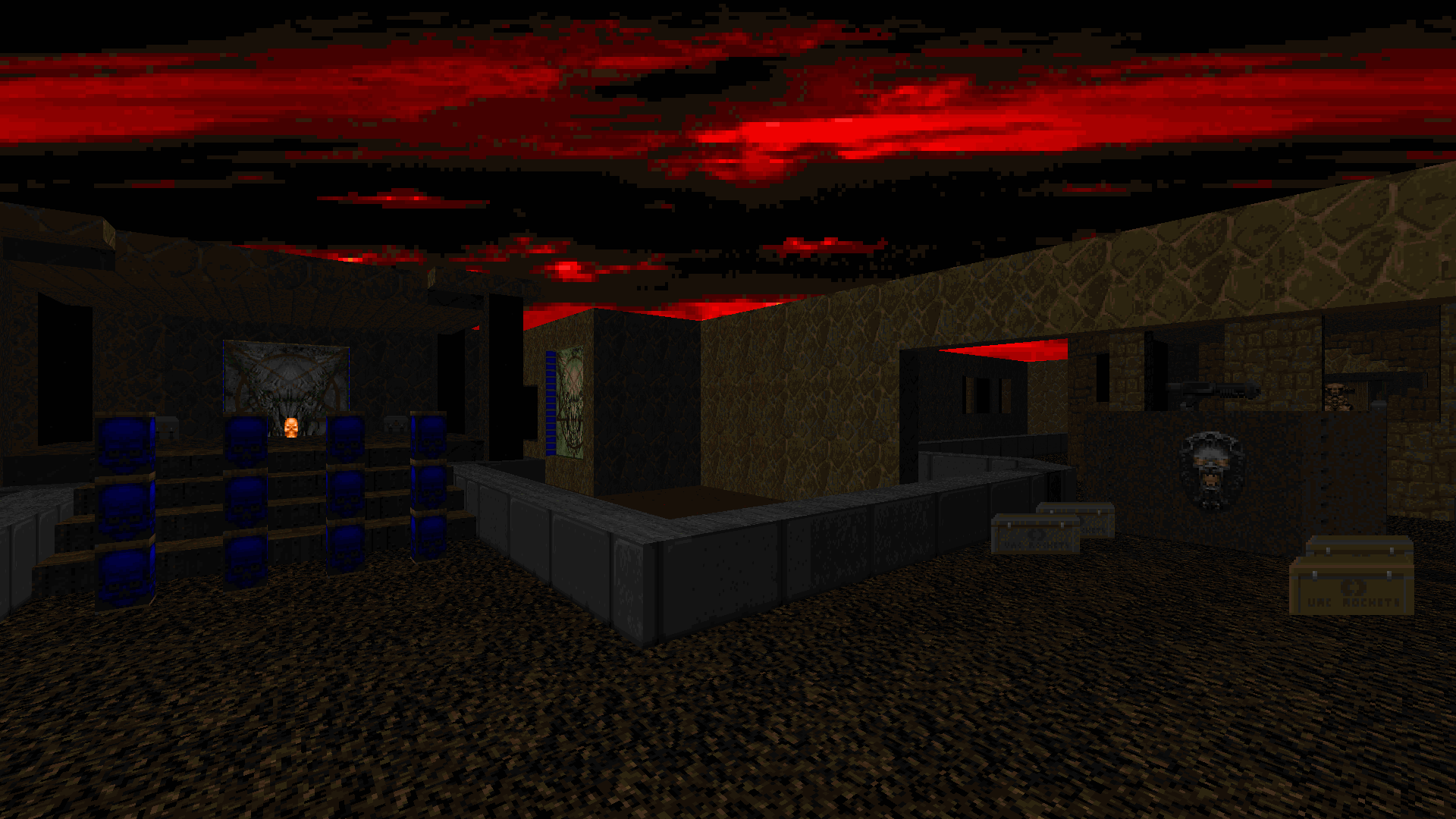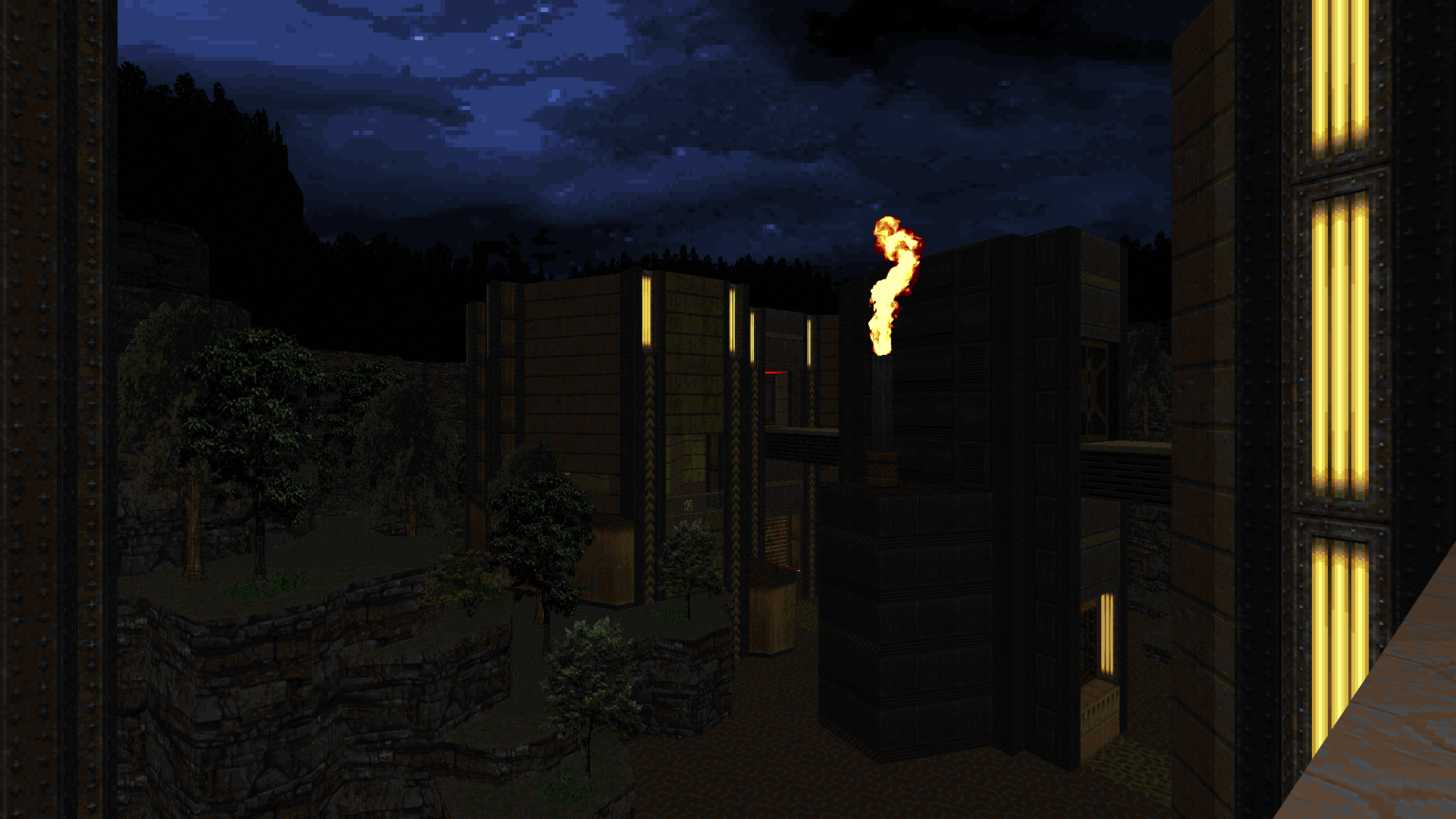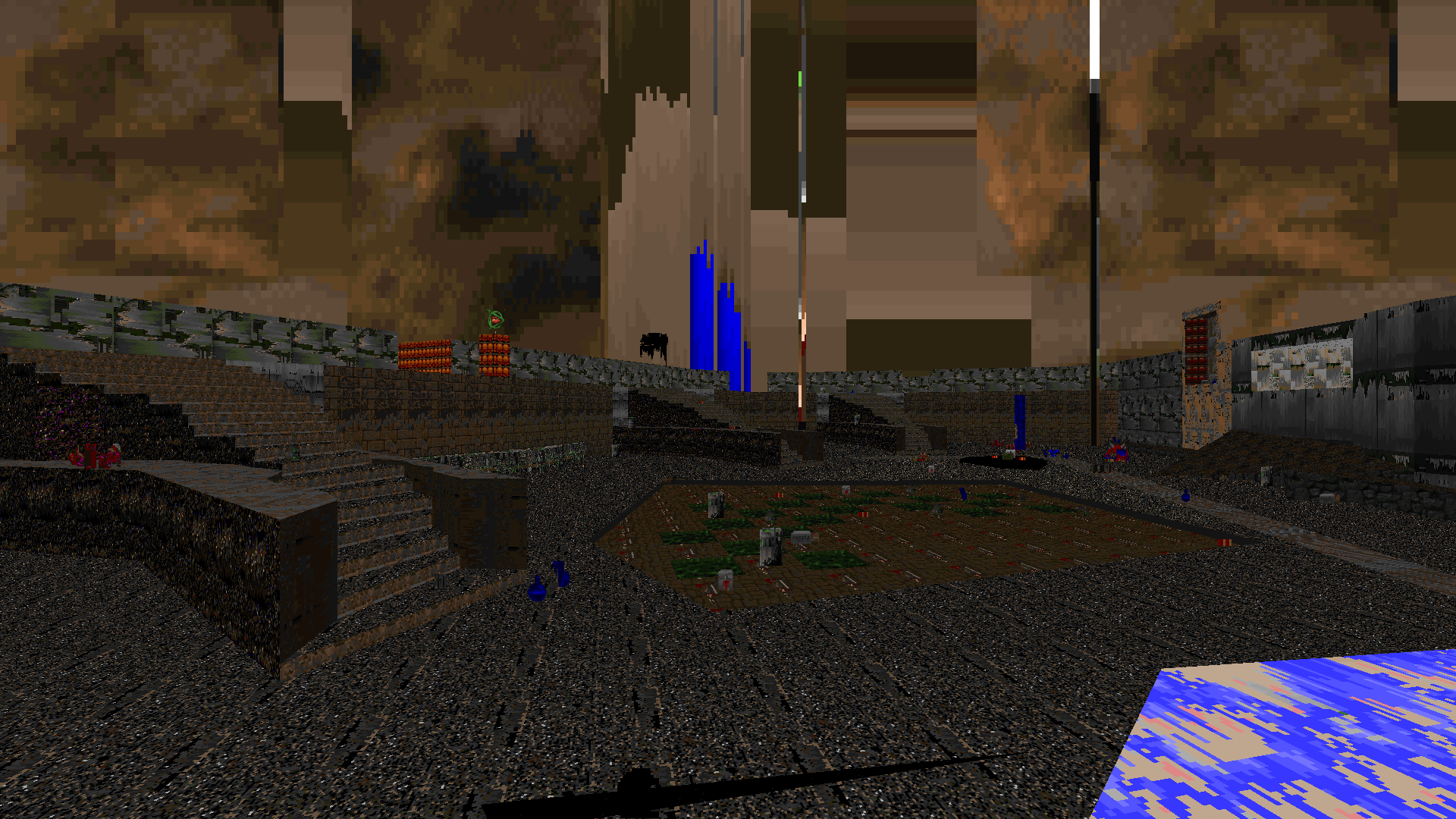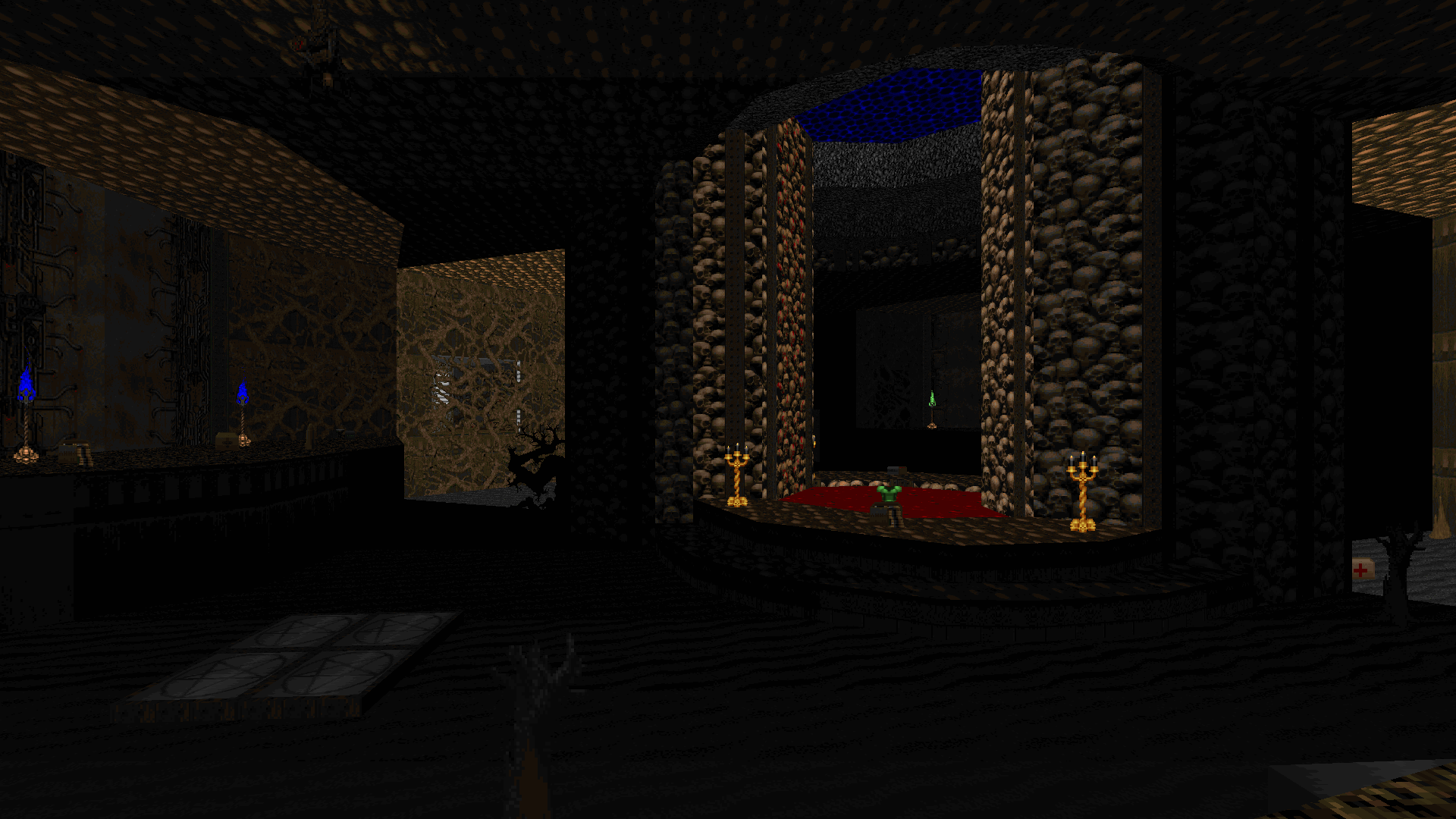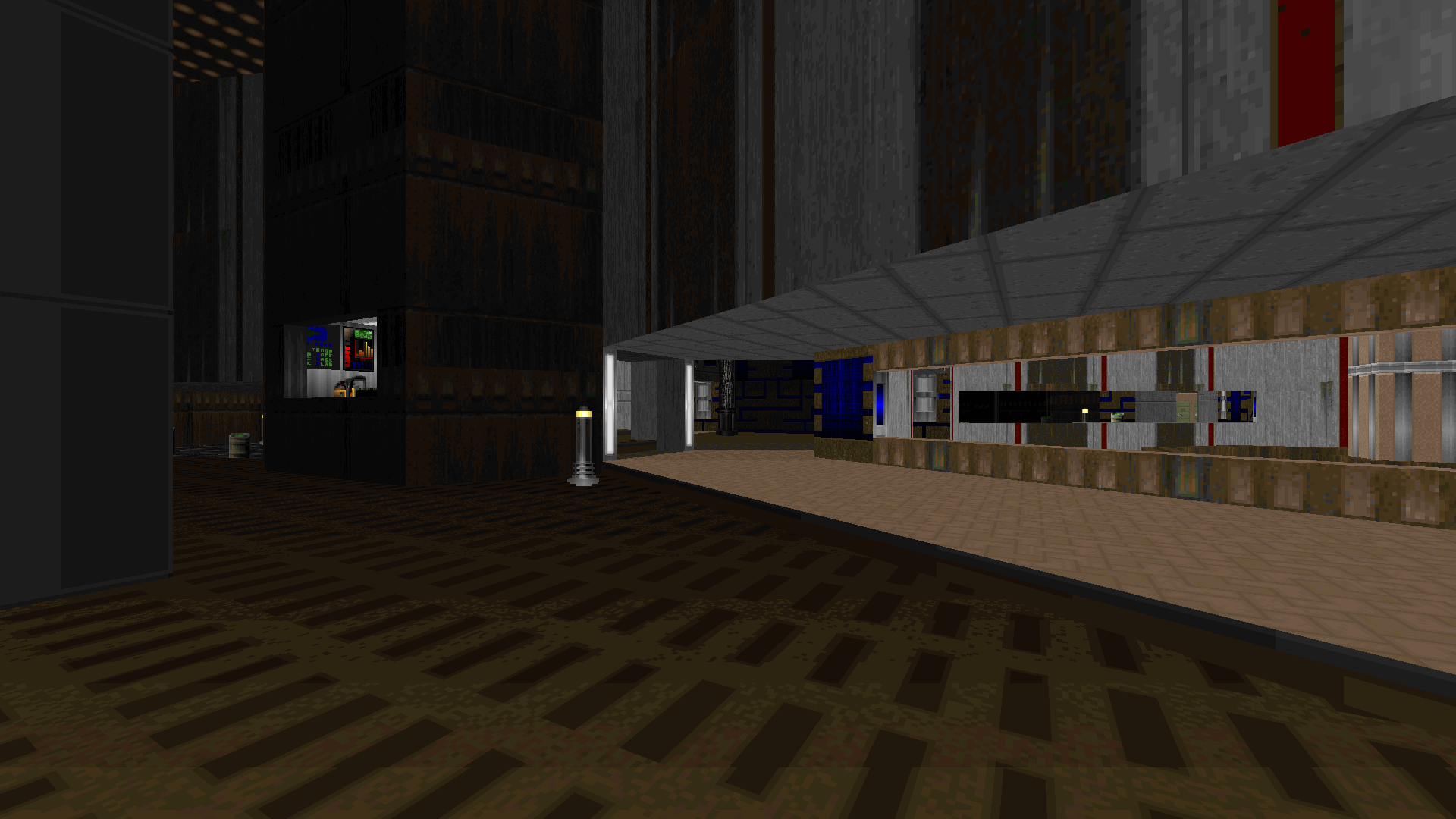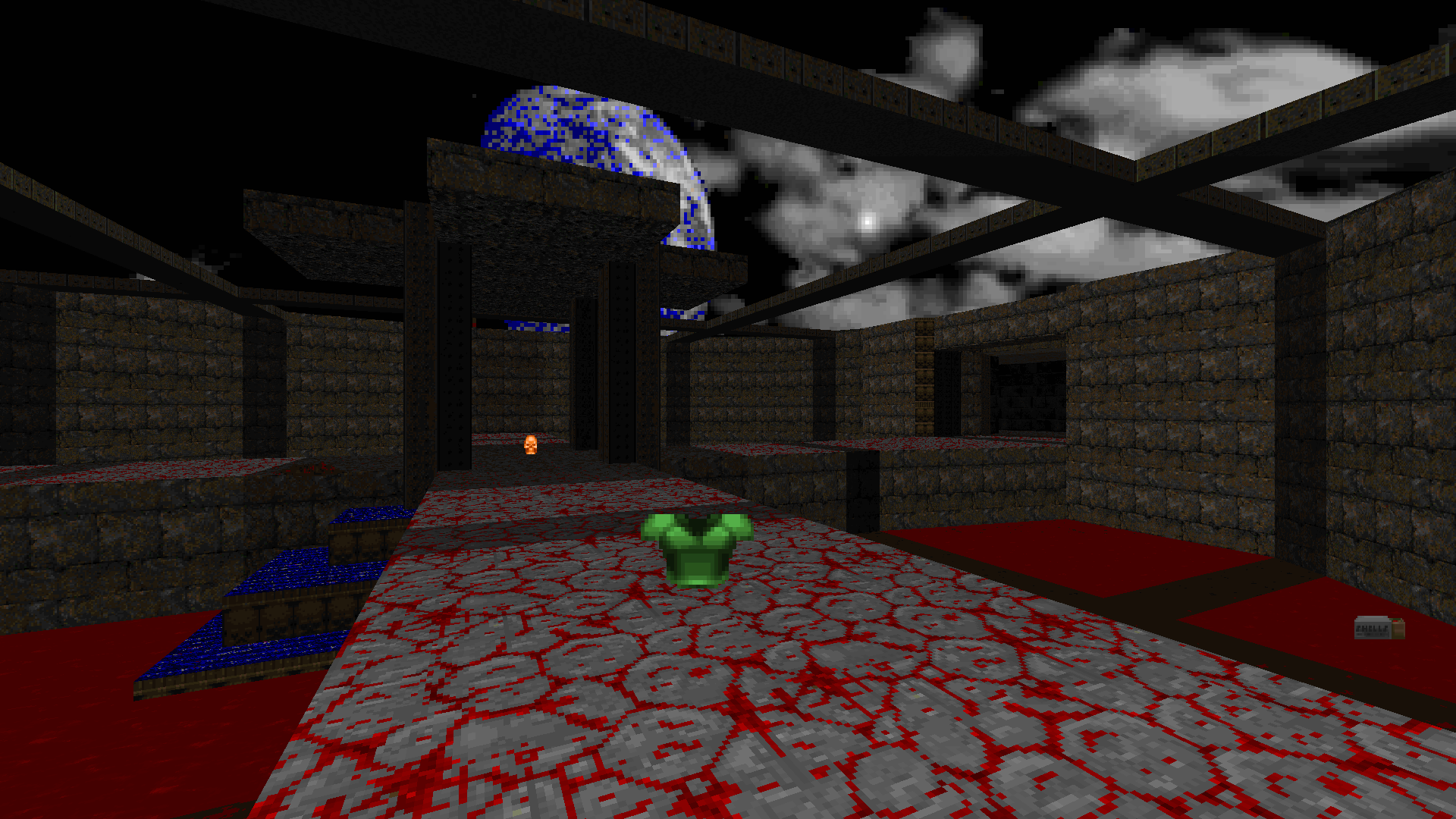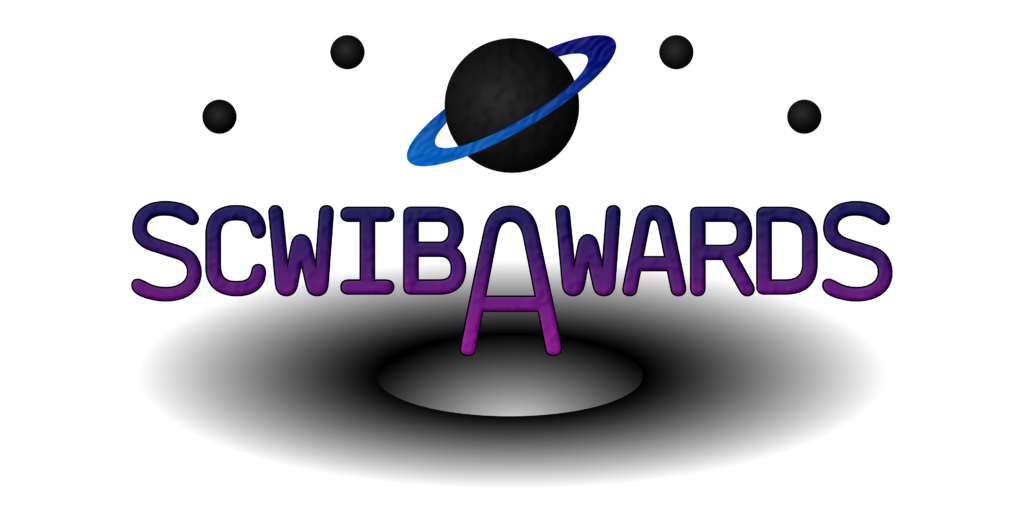
I can’t quite believe that I’ve been writing about Doom since 2012, and here we find ourselves in the far-flung future of 2022. Turn the clock back another ten years, all the way back to 2002, and you’d find me discovering the vast universe of custom Doom content for the very first time. I could never have suspected then how deeply I’d ultimately venture into that universe… or how I would contribute to it in my own small way.
For the last decade I’ve tried to pay tribute to the projects that inspired me to open a map editor all those years ago, and also to recognize the staggering volume of creative output from new mappers who seem to spring up every day out of the ether. I’ve loved writing about every single WAD I’ve covered, but there comes a time when it feels like time to move on to other things, you know?
How then to give this whole chapter a proper sendoff? Well, after so much time writing on the subject of Doom, I figure I’ve earned myself the indulgence of a little awards ceremony of my own. And how convenient that we’ve arrived at the thematically appropriate (and not at all forced) 666th installment of my review series! So, in that case, how about capping this off with… say, my six all-time favorite WADs?
Grab yourself a nice hot beverage and let me regale you one last time. Welcome to the first* annual scwibawards!
*and only
WAD Eternal:
Scythe by Erik Alm, with Kim Bach
Were I asked to count my favorite mapsets on one hand, I genuinely can’t conceive of any future in which Scythe does not have a spot reserved on one of those fingers. Other WADs come and go, but Scythe is eternal.
My impression from the greater community is that of Erik Alm’s offerings, Scythe II is the more beloved. I can’t say it’s a mystery why that is, with all of the design philosophies it codified, the traps-per-minute quota, the episodic structure it brought to Doom 2 mapsets. And it’s just phenomenally well-made — some of the most fun you can have playing Doom. Erik Alm at his peak Erik Alm. For me, though, the choice could not be clearer: as good as Scythe II is, Scythe is better.
I don’t know that it was quite as trend-setting, or has been imitated to anywhere near the extent of Scythe II, but Scythe is in my opinion the far more interesting mapset. Perhaps because it represents an Erik Alm who hadn’t quite found his signature style, Scythe is far more rough, raw, and creative. Alm has always been a mapping powerhouse, but it’s as if he was being pulled in half a dozen creative directions with this project. What I often forget about Scythe is how varied it is, how experimental it can feel, how different each map is from its neighbors.
What was the first slaughter map you ever played? I suspect I’m not alone in being introduced to the whole concept of slaughter by Scythe’s MAP26. On my original playthrough, I frankly could not believe what I was seeing. Before I even got there, MAP12 was probably the first map to truly unsettle me as a teen. Then in MAP28 I was outrunning death itself — my earliest encounter with what that could be considered a “gimmick” map. And look at me now: the gimmick guy.
I’ve occasionally faulted Alm for a couple maps that I didn’t believe truly fit the Scythe mold, but the reality is that his versatility is one of the greatest strengths of his work. That versatility was never on greater display than it was in the original Scythe. I mean, just ask any player which of the three episodes is their favorite. One may love the id-style run and gun action of the first episode while another prefers the atmospheric stuff in the second episode, or the cruel combat puzzles of the third. But all of them are right, because every episode of Scythe is brilliant.
It’s for good reason that Erik Alm’s influence is still felt today. Maybe the most amazing part is that every mapper can see something different to latch onto in Alm’s maps, to learn from, to incorporate and develop as part of their own style. At this point it’s all quite muddy; tracing back exactly what each of us learned from Alm is impossible, but I know for a fact that we would not be where we are today without him.
The Mastered Limits for Doom II:
Heartland by Paul “skillsaw” DeBruyne
Truth be told, I like my Doom on the vanilla side, and tend to pretty aggressively avoid projects that take advantage of advanced, port-specific bells and whistles. All these fancy visual effects, moving sectors, and room-over-room stuff seemed like unnecessary faff that did nothing to bolster Doom’s core gameplay — gameplay which is the main reason I play this old game. And it’s no secret that I have never entirely understood the buzz around skillsaw as a mapper; his maps were good, I thought, but certainly not earth-shattering. So let me tell you that Heartland shattered my Earth.
These seven maps are the finest, most concentrated Doom experience you can find, accompanied by an impossibly perfect soundtrack by stewboy. There may be other mapsets that I love more, but absolutely none of them have the same power, the same punchiness as Heartland. None soar as high, or flirt so closely with the scorching heat of the sun, in such a tightly woven package. There’s not a shred of fluff to be found, not one room or fight I would cut. Heartland doesn’t overstay its welcome by a single second, and at the end all you want to do is pop back to the first map and give it another go.
And those bells and whistles? I was wrong about those. The rest of you probably knew better already, but I should have trusted in skillsaw to use every feature of the Eternity Engine with restraint and clarity of purpose, and at the same time to create something that could not have existed in any other version of Doom. Every change he weaves into Heartland is there for a reason, to build a sense of place and scale and verisimilitude I’ve never seen in Doom before — to inspire a sense of genuine wonder. Nothing is a distraction from the gameplay I love so much about Doom; rather it’s in service to that gameplay, improving it in so many small ways with every tweak skillsaw makes to the cast of enemies and the arsenal of weapons. Heartland is a revelation. It’s an affirmation that Doom’s formula can be made better, that advanced sourceport features can be used in ways that enhance it, and that even mappers I thought I understood can completely subvert every expectation I had.
When we map for vanilla Doom, there are so many limitations and quirks and even flat-out bugs that hamper us. For me those are some of the reasons I love Doom, and the restrictions they place on me force creativity in new and unexpected ways. I enjoy that process of give and take tremendously — but perhaps it has made me a bit snobbish about sourceports and modifications to the engine. Heartland is what you get when you take the limits completely out of the picture and see what a master mapper can do.
I fear that Heartland may be remembered mostly as a cool little experiment with Eternity-specific engine features, rather than the absolute triumph it is — the culmination of everything skillsaw and stewboy have done up to this moment. Take my word for it when I tell you it is one of the best things our community will ever see.
BFG (Big F#<king Glitch) Edition:
lilith.pk3 by anotak
If a videogame is a tapestry, I’ve long been a wee little insect obsessed with crawling to its edges and testing the boundaries: the places where the fabric comes to an abrupt end, where perhaps it has begun to fray, where you might even make a leap of faith and escape the surface of the tapestry altogether.
I’m not a religious or even very spiritual person, so I hope you’ll forgive the analogy, but to me videogames are often the closest I feel to a spiritual experience. Games are, of course, made by human beings — but inside of the game you can sometimes forget that. At times you can become so immersed in the world that has been created for you as to see it as a place that lives and breathes. And when a game breaks, you glimpse the limits of that creation. You see the edge of the tapestry.
A glitch is the fingerprint left by a god on their creation, and when we witness those fingerprints we become aware of something greater than the world in which we currently dwell. lilith.pk3 is something that exists entirely on that fringe, on the knife’s edge between creation and the unformed nothing. It’s not really breaking at any point — not technically — but it’s made so convincingly glitched as to feel like it is.
anotak has created in lilith something unlike anything else you’ve played, a difficult and disturbing vision that has not and never will be matched. For that reason alone it deserves to be experienced. But don’t make the mistake of assuming it has only one magic trick to show you. No, lilith violates every rule and expectation you bring to the table, reshaping itself at each turn, such that you can never really settle in or understand what you’re in for. And yet in the end it all begins to make a strange kind of sense.
lilith.pk3 is as confusing as it is compelling, as frustrating as it is fascinating, and as hideous as it is beautiful.
The Alpha Gods, Part One:
Nihility: Infinite Teeth by years
You know those alpha builds from early on in Doom’s development? I’ve always been strangely captivated by the barren, incomplete maps. Exploring them in dead silence, I stare at the familiar moonbases covered in textures that never made it into the final game. Confronted by unfinished demons who vanish before my eyes when I shoot them. Climbing a staircase up to a blank wall where I know a hallway should be. It’s like a haunted vision of some alternate universe that no longer exists… that shouldn’t exist.
What if those unsettling, alternate universe maps were a finished, playable episode? Well, it would be called Nihility: Infinite Teeth.
Throughout Nihility are glimpses of areas you’re sure you recognize, but that are woven into unfamiliar new places and wallpapered over with textures that haven’t seen the light of day since Doom was in its earliest stages. Props and item graphics are replaced with their old temp versions. The bestiary is padded out with various palette swaps of other monsters, like the whole package was stitched together in a rush from an unfinished build. And every level is draped in an uncomfortable silence that feels so inappropriate in Doom that it makes your skin crawl. Nihility is exactly what I imagine the Doom alphas would have turned out like without any further refinement — just a mad dash to ship whatever was there already.
From that description, you’d be forgiven for thinking Nihility doesn’t sound like something you’re particularly itching to play. But the result is so, so much more striking than it sounds, and so much more than the sum of its parts. It’s far scarier than the Doom you knew, conventional in its map design perhaps, but eerie in every other way. It’s like the Doom from a fever dream come to life, or a consciousness grasping at fragments of memory in the split second before oblivion. Nihility is a ghost freed from some old id hard drive that time should have forgotten, rushing at you out of the void.
Then with a gasp you come back to the world of the living… back to reality… knowing you’ll never forget what you’ve seen.
The Alpha Gods, Part Two:
Apostasy on Amalthea by Nicolás Monti
Nicolás Monti comes from another world — a realm of non-orthogonal angles and midi-fied pop tunes. Whenever I think of him, I imagine he rules over a neon landscape from atop his throne in a shopping mall where the year 1993 never ended. Occasionally, he draws open the veil between worlds to give us a glimpse of his technicolor wonderland.
Words fail me utterly when it comes to expressing the admiration, the adoration, I have for Monti. Let me say without hesitation right now that he is by every conceivable metric my favorite Doom mapper ever. I don’t pretend to have an encyclopedic knowledge of every WAD or map creator who has graced our little community over its 30-year existence, but in all my Doom playing I have never been so enthralled so reliably by a mapper so prolific. Choosing only one of Monti’s mapsets was a monumental task; in truth, almost any of them could have run away with this award.
Surely nostalgia factors into the decision, I suppose. Is Apostasy on Amalthea Nicolás Monti’s greatest work? No, probably not. There are more recent mapsets that show a clear evolution in his craft, and others that are more interesting conceptually — or simply more fun. But Amalthea is my favorite, a sort of comfort food I return to again and again, and it was this WAD that first introduced me to a weird and wonderful realm I’ve never wanted to leave since.
See, Monti loves to dabble in a Doom alpha aesthetic as well, but his approach is wholly different from Nihility’s bleak version. His is a lighter, more self-aware take on the alpha look — less rust and gore, more plain concrete and brightly-colored mystery liquids. He creates a sort of knowing badness, a calculated jank, an ugliness that stems from cutting textures off awkwardly, tiling them in ways that were never intended, and juxtaposing elements and themes that wouldn’t work together in the hands of any other mapper. And all this he slathers with catchy pop songs and campy tunes from other games you’d never associate with Doom’s ultra-violence.
Nicolás Monti is a purveyor of magic. His maps are nothing short of sorcery, effortlessly inventive in their design, impossibly charming in their weirdness, and conveying a mood utterly unique within the Doom sphere. I recognize that I’m in the minority as someone who adores Monti’s body of work to such a ridiculous degree, and probably in an even smaller minority as someone who would hold up Apostasy on Amalthea as the pinnacle of that body of work. And there may be other Monti mapsets that are a better place to start — Alpha Centauri, 60 Secrets, or Mass Extinction perhaps — but he is a creator you cannot afford to sleep on.
The Ultimate Doom:
STRAIN by The Alpha Dog Alliance
STRAIN was among the first WADs I stumbled upon back in 2002. I fell in love immediately. Twenty years and countless hundreds of maps later, my love has never waned or wavered. Time has merely cemented STRAIN, certain beyond certainty, as my favorite WAD of all time. For over a decade I’ve wanted to write about it one day, and I guess today is that day.
STRAIN is the real deal — a complete package. Project lead Charlie Patterson set out to create a supergroup modding team with the Alpha Dog Alliance, pulling together a who’s who of the biggest names in the Doom scene. Adam Windsor, Anthony Czerwonka, Björn Hermans, and Holger Nathrath — just to name a few — all contributed maps to the project. The soundtrack was mostly a joint effort by midi composing royalty Mark Klem and David Shaw, but with some hugely underappreciated bangers by Jon Landis. And custom graphics, of which there are boatloads, were handled by artists including Patterson himself as well as the legendary Iikka Keränen.
It was a project that reached for the stars, and despite numerous setbacks and scale-downs over the course of its development I think still stuck the landing. If you look into STRAIN’s development, you’ll find that it began its life as a much more ambitious project, and while I still see it occasionally called a “total conversion,” the final product is anything but “total” in that sense. The team’s original vision was of an almost completely new game, requiring Doom in order to install but replacing most of its graphics, sounds, and enemies. When those aims proved to be too lofty, the project transformed into a direct sequel to Doom II: the STRAIN we know today.
I’m a sucker for a story… even in Doom WADs. That’s where your STRAIN journey should begin: with the admittedly somewhat over-earnest but genuinely compelling plot setup you can read here. Some doctors of questionable morality have administered an experimental combat drug to our hero Doomguy, conveniently just in time for a new demonic outbreak on Earth’s moon. So it’s up to you, under the influence of this barely tested drug, to save the Earth from a new strain of hellspawn who have had their own enhancements at the hands of rogue UAC scientists. It’s pulpy stuff, but perfectly sets the scene for your mission to the lunar research outpost, and for the horrors you’ll discover there.
What follows is your descent into both the corrupted Moonbase Daro and into your own paranoia and rage. As you become more powerful, more lethal demonic experiments rise to meet you: imps that move at lightning speed, flayed demons with their raw muscle exposed, super-resilient white Hell nobles. Even the base’s automated sentry drones are now programmed to kill. Much of the story is inferred, but the little snippets of ingame text brilliantly paint the picture of a Doomguy quickly losing his grasp on sanity, meeting each new mutant threat with the sick glee of a killer barely restrained.
STRAIN’s new cast of characters is probably its strongest selling point, and seem to mostly be the result of Charlie Patterson’s desire for more “balanced” enemies. Ironically, I think the changes Patterson fought for here kind of stem from him being… well, bad at Doom II. There’s an interview where he talks about how uninteresting and unfair he finds the Doom II-specific monsters, which I think might be about as wrong as you can possibly be about a Doom topic. At the same time, that sentiment was the reason for a lot of the coolest changes in STRAIN: the souped-up imp variant was an attempt at nerfing the arachnotron; the holobot is essentially a flying revenant but whose projectiles drift around at a lazy pace, making them way easier to dodge but a hell of a lot harder to shake. Both of Doom’s biggest nasties, the cyberdemon and spider mastermind, also got major power downgrades — but that means mappers could use their stand-ins much more frequently, and as regular enemies rather than bosses.
I feel compelled to mention something for newer players coming to this WAD now 25 years after its release and expecting graphical fidelity on par with something like Brutal Doom: a lot of the new sprites in STRAIN could be better. Some are the result of less than stellar scaling or recoloring, with the player sprite in particular looking like it got mangled at some point between various imports and exports and was just never fixed. Others are made in mid ’90s consumer 3D modeling software and have a distinctly dated, low-poly, untextured look to them. All this I find charmingly quaint, but if professional grade pixel art is all you’ll settle for, I suggest you look elsewhere.
The maps, though, are the be-all and end-all for any Doom WAD, and I’ve said nothing yet of STRAIN’s maps. In part, that’s because I don’t know where exactly to start. Even without all the gameplay changes, STRAIN’s levels alone would put it among my favorite WADs. I know some people have their issues with certain maps in the lineup, but from my perspective every single one of them is trying (and usually succeeding) to do something awesome and unique. Do a few fumble in the execution? Sure, but I find it a little difficult to hold that against a 25-year-old map made with tools I wouldn’t even be able to wrap my head around today. And when sandwiched on either side of that underwhelming map are two of the most memorable ones I’ve ever played in my life.
Each of STRAIN’s levels is encoded into my brain right there next to the Konami code and every line of dialogue from that Kevin Costner Robin Hood movie I watched 100 times as a kid. The Alpha Dog Alliance not only managed to keep techbases interesting for a solid 32-map megaWAD, they also came up with enough variety in the formula that each of them stands out from the crowd. And still the project gels together wonderfully because of the distinct look of Base Daro, and the real sense of progression Patterson insisted on.
Continuous play was clearly a priority for STRAIN, with weapons like the rocket launcher and beyond not being doled out until about halfway through the WAD. Likewise, new enemies are introduced at a trickle so that each one you encounter is a surprise and thrill. The pacing of STRAIN gives it the feel of a mystery slowly unraveling, or a horrible truth coming to light. The music, at times sad, at times creepy, and at times full of a wild energy, heightens every step of the journey. And that’s what it is — a journey — so much more so than any other mapset I’ve played.
STRAIN is a complete package, to me the most well-rounded WAD out there. A proper Doom II sequel. Even twenty years after I discovered it it still inspires my own mapping, still delights with its new villains and gadgets, still captivates with its sense of isolation and desperation. And still leaves me wondering how Doomguy got out of this particular jam. Of all the dire situations he’s been placed in, the end of STRAIN seems like it might have been the worst. I hope the dude is okay up there.
Thank you to all those who have read my reviews over the last ten years. I’ll see you on a moonbase out there somewhere.
